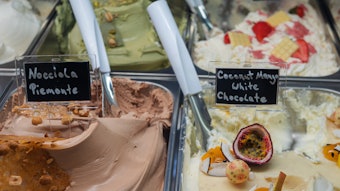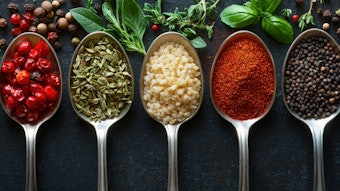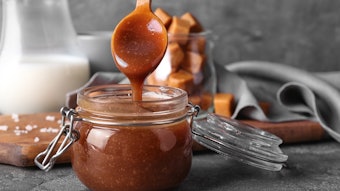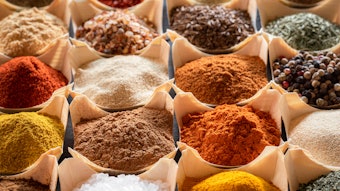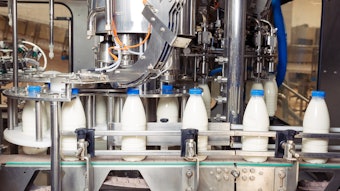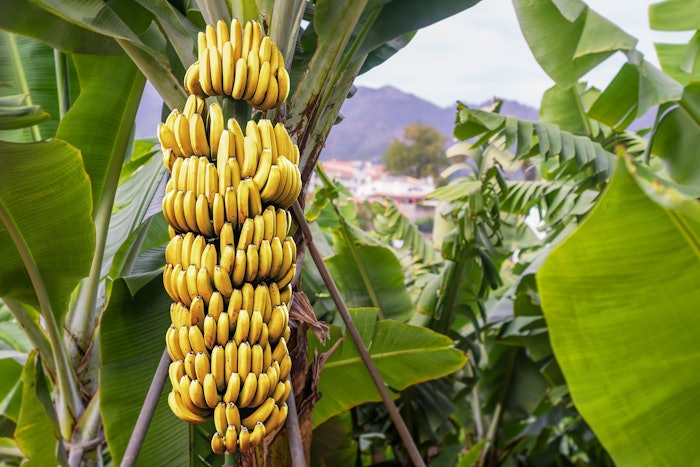
Isoamyl acetate, or 3-methyl butyl acetate (FEMA GRAS #2055, CAS #123-92-2) is produced in increasing amounts in many fruits as they ripen. It is also a central component of many fermented beverages. These are big positive attributes. Less appealing is the fact that it is the main honey bee sting alarm pheromone (be careful not to smell banana flavors near a beehive).
This article is only available to registered users.
Log In to View the Full Article
Isoamyl acetate, or 3-methyl butyl acetate (FEMA GRAS #2055, CAS #123-92-2) is produced in increasing amounts in many fruits as they ripen. It is also a central component of many fermented beverages. These are big positive attributes. Less appealing is the fact that it is the main honey bee sting alarm pheromone (be careful not to smell banana flavors near a beehive).
There is an unfortunate temptation to automatically associate Isoamyl acetate with tutti frutti and other profiles from the past. In reality it is a uniquely important ingredient in contemporary flavors. It is particularly useful at modest levels when the goal is to accentuate ripeness.
Note that the dose rates given throughout this article are the levels suggested for use in flavors intended to be dosed at 0.05% in ready-to-drink beverages or in a simple bouillon.
Tropical Fruit Flavors
Banana: Isoamyl acetate is, first and foremost, a banana chemical. It can be used in banana flavors at a range of levels, but 15,000 ppm is a good place to start.
Guava: This ingredient only serves to add a hint of ripeness to guava flavors at around 100 ppm.
Jackfruit: The effect in jackfruit flavors is fairly central to the profile. Four thousand ppm is very effective.
Mango: The same 4,000 ppm level of addition is similarly central to mango flavors.
Pineapple: Isoamyl acetate broadens the impact of the dominant ethyl esters and adds brightness. Five hundred ppm works well.
Tree Fruit Flavors
Apple: This ester is clearly not the main driver in apple flavors, but it does add impact and complexity at levels of addition in the region of 2,000 ppm.
Apricot, Fresh: Fifteen hundred ppm of isoamyl acetate brighten fresh peach flavors and provide a welcome contrast to the dominant lactones and linalool.
 Cherry flavors can use moderate additions of isoamyl acetate to enhance ripeness.Olesia at Adobe Stock
Cherry flavors can use moderate additions of isoamyl acetate to enhance ripeness.Olesia at Adobe Stock
Cherry: Cherry flavors can use moderate additions of isoamyl acetate to enhance ripeness. Seven hundred ppm works well.
Grapefruit, Lemon and Orange: Isoamyl acetate should not be the driver of the ester note in juicy versions of these popular citrus flavors, but it does add ripeness at levels ranging from 20 to 80 ppm.
Peach: The contrast with the, predominantly gamma, lactones also works well in peach flavors at levels of isoamyl acetate around 1,000 ppm.
Pear: There is a close relationship between banana and pear ester notes. Six thousand ppm of isoamyl acetate balances hexyl acetate perfectly.
Plum: Plum flavors benefit more than most from an impression of ripeness. Five hundred ppm of this raw material achieves that effect.
Berry Fruit Flavors
Blueberry: Levels of addition of isoamyl acetate in berry flavors are often relatively modest. In blueberry flavors, the ideal range is between 50 and 100 ppm.
Elderberry: One hundred ppm is also very effective in elderberry flavors, adding brightness and ripeness.
Gooseberry: The challenge in gooseberry flavors is to keep the level of methyl butyrate high without ending up with a profile lacking depth. One thousand ppm of isoamyl acetate goes some way towards solving the problem.
Strawberry, Fresh: It is quite practical to simply use ethyl butyrate as the only aliphatic ester in a fresh strawberry flavor. Ethyl 2-methyl butyrate is an obviously worthwhile addition. Beyond that, opinions tend to differ widely. There are many options, but isoamyl acetate adds helpful complexity at 200 ppm.
Other Fruit Flavors
Kiwi: The delicate balance of ester notes in kiwi flavors is enhanced and ripened by the moderate addition of 200 ppm of isoamyl acetate.
Melon: Isoamyl acetate is the most important ester in both authentic cantaloupe melon flavors and the somewhat fantasy-oriented commercial watermelon flavors. Levels of addition can be very high, ranging up to 20,000 ppm.
Pomegranate: Pomegranate flavors are not quite in the same league as melon flavors, but still benefit from a good level of isoamyl acetate, around 2,000 ppm.
Alcoholic Drinks Flavors
Beer: This raw material is effective in all types of beer flavors, ranging from the darkest to the lightest. Levels vary, but are generally in the range from 500 to 1,000 ppm.
 Isoamyl acetate provides some useful contrast in brandy flavors.5ph at Adobe Stock
Isoamyl acetate provides some useful contrast in brandy flavors.5ph at Adobe Stock
Brandy: The driving aliphatic esters in brandy flavors are the higher ethyl esters, but they can become a little yeasty in isolation. Isoamyl acetate provides some useful contrast at 200 ppm.
Rum: High levels of isoamyl acetate can work in dark rum flavors, but a more authentic effect is achieved at lower levels of addition, typically in the low hundreds of ppm.
Whisky: Isoamyl alcohol has an interesting effect in whisky flavors, adding a soft edge to the fusel notes derived in large part from the parent alcohol. Whisky flavors cover a very wide range of different profiles and the levels of addition reflect this. One hundred ppm is a very cautious starting point.
Wine: Levels of isoamyl acetate in wine flavors can range from several hundred up to 1,000 ppm, perhaps higher in white wine flavors.
Other Flavors
Caramel and Toffee: Caramel and toffee flavors tend towards the heavier end of the flavor spectrum, which can become dull. Isoamyl acetate freshens things at levels in the region of 100 ppm.
Coconut: This ester may only make a tiny contribution to typical coconut flavors, but it has a definite freshening effect in coconut water flavors. Levels vary, with the most realistic effect being at around 20 ppm.
Dandelion and Burdock: Dandelion and burdock flavors are a peculiar UK specialty. They diverged completely from root beer with the demise of sassafras oil. Isoamyl alcohol forms an attractive part of the fantasy profile at levels in the region of 7,000 ppm.

